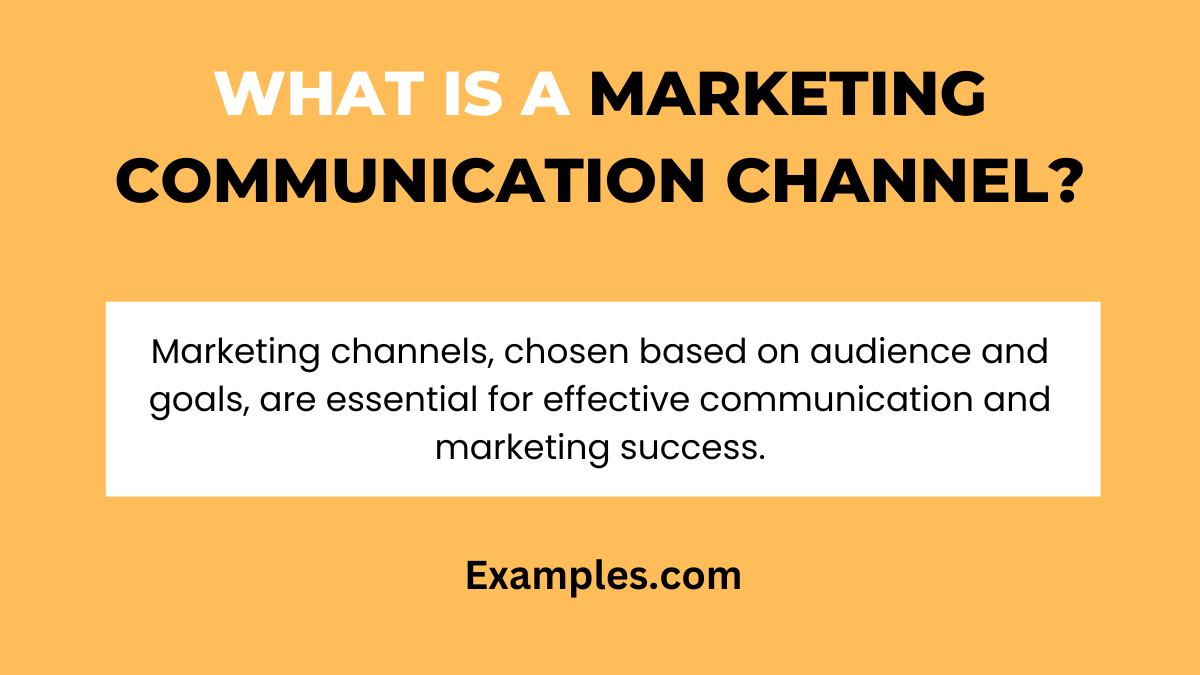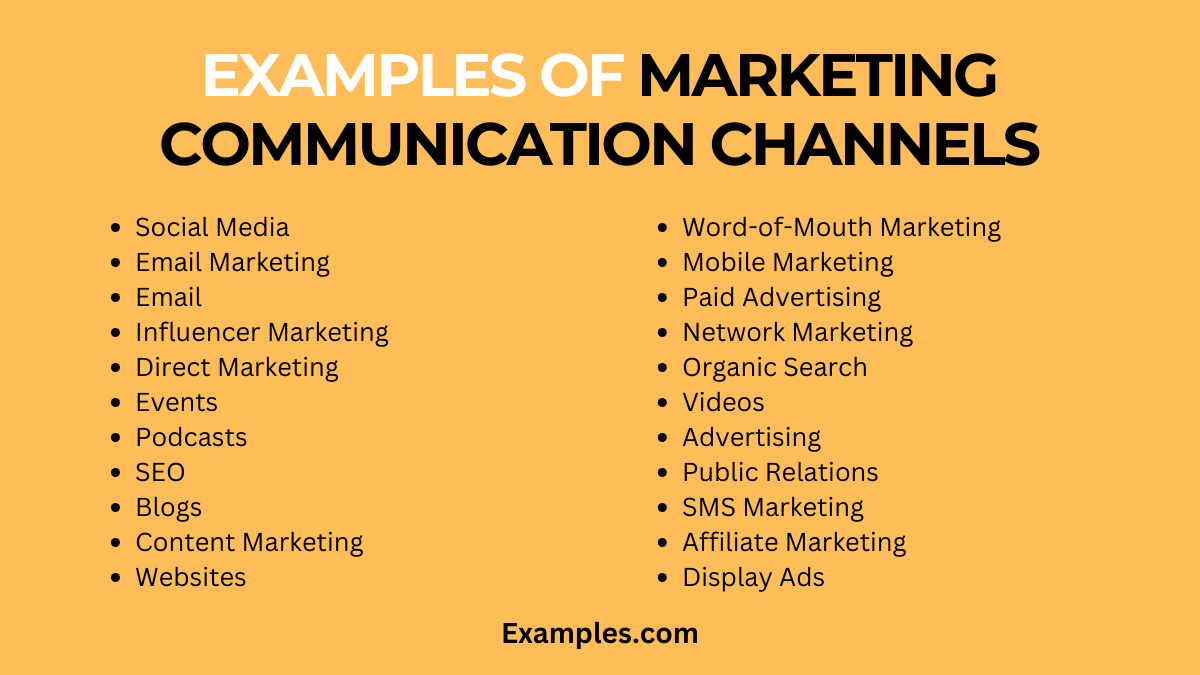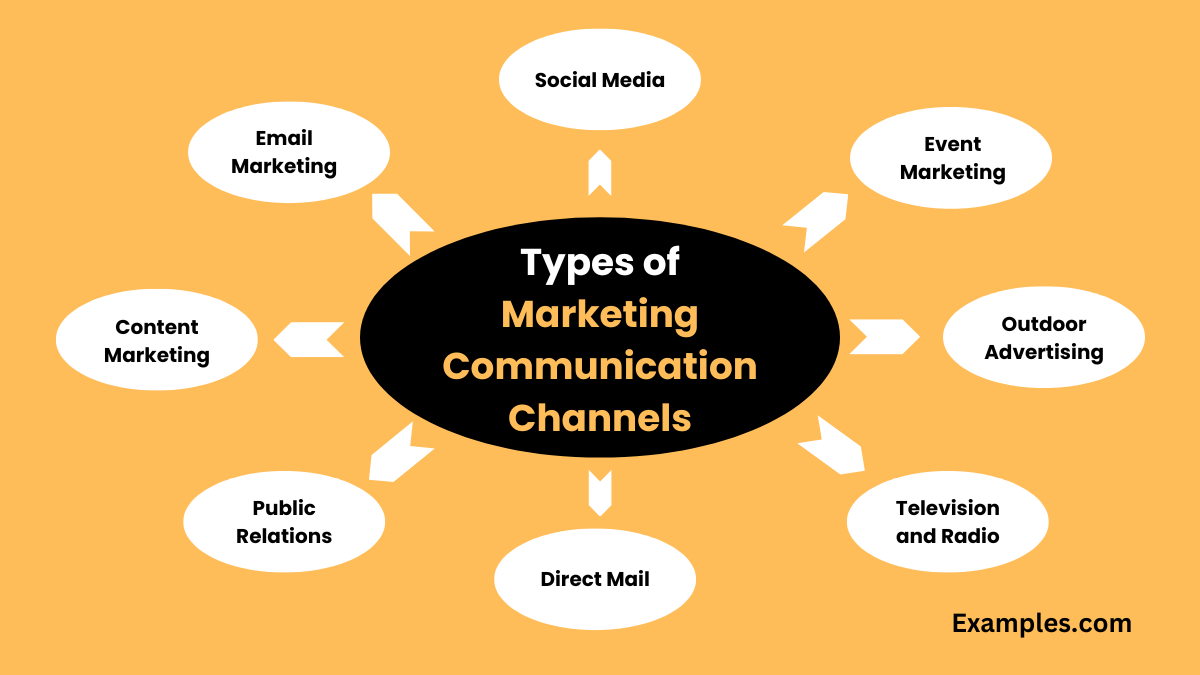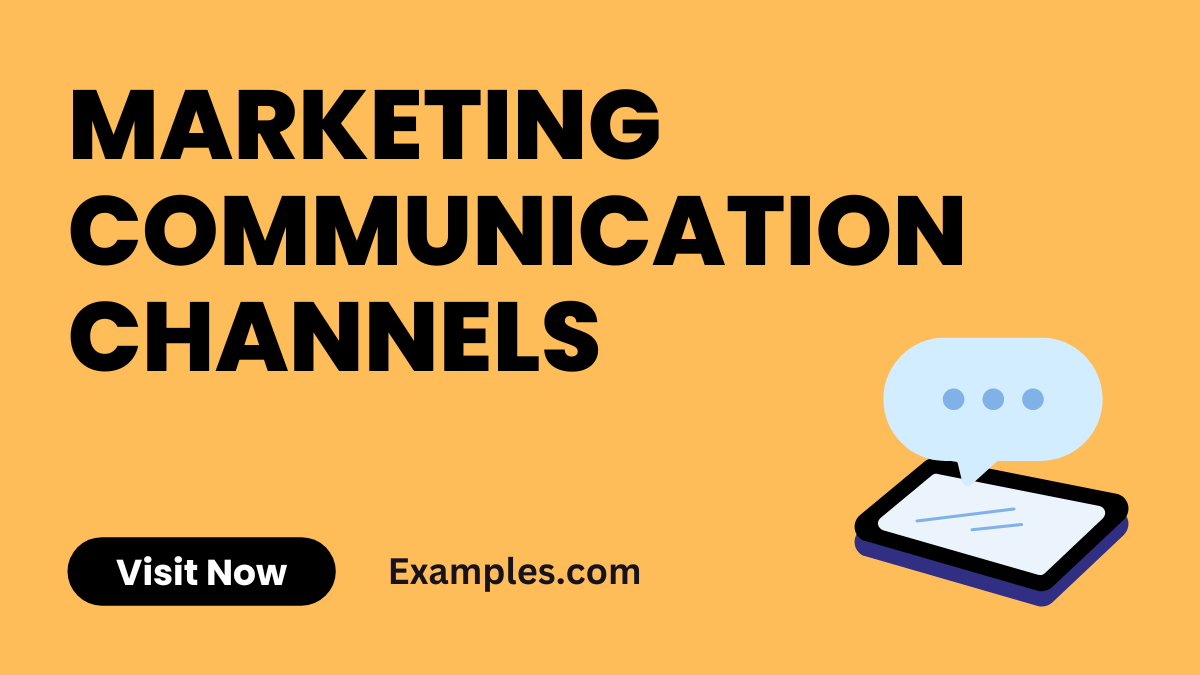25+ Marketing Communication Channels Examples
Exploring the diverse world of marketing communication channels is crucial for any successful marketing strategy. This guide delves into various channels, each with its unique strengths, and demonstrates how they can effectively convey your brand’s message. From traditional advertising to the dynamic realm of digital marketing, we include vivid Marketing Communication Examples to illustrate the power and versatility of these channels. Understand how each medium can be optimized to reach your target audience, engage them effectively, and drive your marketing objectives.
What is a Marketing Communication Channel?

Marketing communication channels are the mediums through which a company conveys its marketing message to its target audience. These channels range from traditional forms like print and broadcast media to digital platforms such as social media and email. The choice of channel depends on the audience’s preferences, the nature of the message, and the goals of the marketing campaign. Understanding these channels is essential for effective communication and achieving marketing success.
What is the Best Marketing Communication Channel?

Determining the best marketing communication channel varies based on the specific goals, target audience, and content of a campaign. It’s about finding the right mix that resonates with your audience and aligns with your marketing objectives. For some, social media might be the most effective, while for others, email marketing or direct advertising could yield better results. It’s about strategic selection and customization to fit your unique marketing needs.
25 Marketing Communication Channels

- Social Media: Engage directly with your audience through platforms like Facebook, Instagram, and Twitter.
Example: Create interactive posts on Instagram to showcase new products and encourage user-generated content. - Email Marketing: Send personalized messages and updates to your subscribed users.
Example: Develop a monthly newsletter with product updates, industry news, and special offers. - Email: Use email for targeted communication and nurturing leads.
Example: Send a series of welcome emails to new subscribers, introducing your brand and values. - Influencer Marketing: Collaborate with influencers to tap into their followers and gain credibility.
Example: Partner with a popular lifestyle blogger to promote your wellness products. - Direct Marketing: Reach customers directly through mail, telemarketing, or texting.
Example: Send personalized postcards to loyal customers with exclusive discounts. - Events: Host or participate in events to connect with customers and industry peers.
Example: Organize a product launch event and invite industry influencers and media. - Podcasts: Create or sponsor podcasts to reach niche audiences with specific interests.
Example: Start a podcast series discussing the latest trends in your industry. - SEO: Optimize your online content to rank higher in search engine results.
Example: Use targeted keywords in your blog posts to improve visibility for those searching for related topics. - Blogs: Share insights, updates, and valuable content through a company blog.
Example: Write weekly blog posts covering industry news, how-to guides, or customer stories. - Content Marketing: Create and distribute valuable content to attract and retain customers.
Example: Develop an e-book on best practices in your field and offer it as a free download. - Websites: Use your website as a central hub for information, sales, and customer interaction.
Example: Design an interactive and informative website with easy navigation and clear calls to action. - Word-of-Mouth Marketing: Encourage satisfied customers to share their experiences with others.
Example: Implement a referral program that rewards customers for bringing in new clients. - Mobile Marketing: Reach customers on their mobile devices through apps, SMS, or mobile-optimized content.
Example: Develop a mobile app that offers exclusive content and features for users. - Paid Advertising: Utilize paid channels like Google Ads or social media advertising.
Example: Run targeted ad campaigns on Facebook to reach potential customers based on their interests. - Network Marketing: Leverage personal networks for direct selling and building customer relationships.
Example: Create a community of brand ambassadors who share your products within their networks. - Organic Search: Enhance your online presence through unpaid search engine results.
Example: Regularly update your website with SEO-friendly content to improve organic search rankings. - Videos: Use video marketing on platforms like YouTube or integrated into your website.
Example: Create tutorial videos about your products and share them on YouTube. - Advertising: Traditional advertising on TV, radio, or print to reach a broad audience.
Example: Develop a creative TV ad campaign that aligns with your brand’s personality. - Public Relations: Manage the spread of information between your company and the public.
Example: Issue press releases to announce significant company milestones or product launches. - SMS Marketing: Send promotional messages or updates directly to customers’ phones.
Example: Use SMS alerts to inform customers about flash sales or special events. - Affiliate Marketing: Partner with affiliates who promote your products for a commission.
Example: Create an affiliate program where bloggers can earn a commission for every sale they refer. - Display Ads: Use online display advertising to capture the attention of web users.
Example: Place display ads on relevant websites to target potential customers. - Partnerships: Collaborate with other businesses for co-marketing initiatives.
Example: Partner with a complementary business to co-host a webinar or joint promotion. - Internal Communication: Communicate effectively within your organization to ensure aligned marketing efforts.
Example: Hold regular meetings with your marketing team to discuss strategies and progress. - Community Engagement: Participate in community events or forums to build brand presence locally.
Example: Sponsor local events or charities that align with your brand values.
Each of these channels offers unique opportunities for engaging with your audience, and the right combination can significantly enhance your marketing communication efforts.
Importance of Marketing Communication Channels?
- Reaching Target Audiences: Different channels allow businesses to reach specific segments of their target audience.
Example: Instagram is effective for reaching a younger demographic interested in visual content. - Enhancing Brand Visibility: Utilizing multiple channels increases the visibility of a brand.
Example: Coca-Cola uses TV ads, billboards, and social media for widespread visibility. - Facilitating Customer Engagement: Engagement can be tailored to each channel for better customer interaction.
Example: Twitter is used by brands for real-time customer service. - Cost-Effective Marketing: Selecting the right channels can be cost-efficient while reaching the desired audience.
Example: Email marketing is a cost-effective way to reach loyal customers. - Measuring Marketing Effectiveness: Different channels offer unique analytics for measuring campaign success.
Example: Google Analytics for tracking website traffic and user engagement. - Supporting Personalized Marketing: Channels like email allow for personalized communication with customers.
Example: Amazon’s personalized product recommendations via email. - Building Brand Loyalty: Consistent and engaging communication helps in building loyalty.
Example: Loyalty programs communicated through mobile apps. - Diversifying Marketing Strategies: Using various channels allows for diverse marketing strategies.
Example: A combination of content marketing and PPC ads for a holistic approach. - Adapting to Consumer Preferences: Different channels cater to different consumer preferences.
Example: YouTube for audiences preferring video content. - Integrating Marketing Efforts: Channels can work together for an integrated marketing approach.
Example: Social media posts driving traffic to a website.
Types of Marketing Communication Channels

- Social Media: Platforms like Facebook, Instagram, and LinkedIn for interactive marketing.
Example: Brands using Instagram Stories for product launches. - Email Marketing: Sending targeted messages and promotions to a subscriber list.
Example: Weekly newsletters from a fashion retailer to its subscribers. - Content Marketing: Blogs, articles, and videos to engage and inform the audience.
Example: A tech company publishing how-to guides on its blog. - Public Relations (PR): Managing public perception through press releases and events.
Example: Press conferences for major company announcements. - Direct Mail: Physical mail for personalized marketing efforts.
Example: Postcards or catalogs sent to a select customer list. - Television and Radio: Traditional but wide-reaching media for advertising.
Example: Nationwide TV commercials for new product launches. - Outdoor Advertising: Billboards and signage for high-visibility marketing.
Example: Billboard ads in high-traffic areas for brand awareness. - Event Marketing: Hosting or participating in events to engage with the audience.
Example: Trade shows for networking and product demonstrations. - Influencer Marketing: Collaborating with influencers for targeted audience reach.
Example: Partnering with fashion influencers on Instagram for clothing promotion. - Webinars and Online Workshops: Digital platforms for educational marketing.
Example: Free webinars to educate customers about financial planning.
Digital Marketing Communication Channels
- Search Engine Optimization (SEO): Optimizing website content for higher search engine rankings.
Example: Using targeted keywords to improve Google rankings. - Pay-Per-Click (PPC) Advertising: Ads on search engines and websites where advertisers pay per click.
Example: Google AdWords campaigns for immediate traffic boost. - Social Media Advertising: Paid advertising on social media platforms.
Example: Facebook ads targeted based on user demographics and interests. - Content Marketing: Creating valuable content to attract and retain customers.
Example: A health brand’s blog with fitness and nutrition tips. - Email Marketing: Using email to communicate with prospects and customers.
Example: Monthly newsletters with updates and special offers. - Affiliate Marketing: Partnering with individuals or companies to promote products.
Example: Fashion bloggers promoting clothing brands through affiliate links. - Mobile Marketing: Reaching customers through mobile devices.
Example: SMS promotions for flash sales. - Influencer Marketing: Collaborating with online influencers for brand promotion.
Example: Beauty brands partnering with YouTube influencers for product reviews. - Video Marketing: Using video content for promotion on platforms like YouTube.
Example: Instructional videos demonstrating product use. - Display Advertising: Banner ads on websites and blogs.
Example: Display ads on popular blogs related to the brand’s industry.
How to choose the Right Marketing Communication Channel for Business
- Understand Your Audience: Identify where your target audience spends their time.
Example: If targeting young adults, consider channels like Snapchat or TikTok. - Define Your Objectives: Align channels with specific marketing objectives.
Example: Use SEO for long-term organic traffic growth. - Consider Your Budget: Choose channels that fit your marketing budget.
Example: Startups may prefer social media for its cost-effectiveness. - Analyze Competitors: See where competitors are successfully engaging their audience.
Example: If competitors are thriving on LinkedIn, consider it for B2B marketing. - Evaluate Channel Effectiveness: Assess past performance of different channels.
Example: Reviewing previous email campaigns for open and click-through rates. - Content Suitability: Select channels that best suit your type of content.
Example: Instagram for visually appealing content like fashion or travel. - Integration Possibilities: Consider how channels can work together.
Example: Using social media to drive traffic to your website. - Scalability: Choose channels that can grow with your business.
Example: Digital channels like SEO and content marketing that scale over time. - Customer Preferences: Consider where your customers prefer to receive information.
Example: B2B customers might prefer detailed information via email. - Flexibility and Control: Channels that offer control over messaging and targeting.
Example: PPC advertising for control over budget and targeting.
Each of these aspects plays a critical role in selecting the most effective marketing communication channels for a business, ensuring that the marketing efforts are well-targeted, cost-effective, and aligned with the overall business strategy.
In conclusion, selecting the right marketing communication channels is pivotal for business success. By understanding your audience, aligning with business objectives, and considering budget and content compatibility, businesses can effectively reach and engage their target market. Utilizing these channels strategically ensures a comprehensive and impactful marketing strategy, essential in today’s competitive landscape. Remember, the key lies in thoughtful planning and continuous evaluation.



